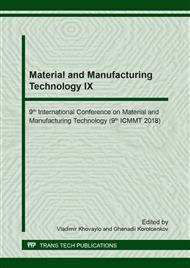p.43
p.48
p.57
p.62
p.67
p.74
p.80
p.93
p.98
Manufacturing Refractory Bricks Using Exhaust Dust from Foundry Industries
Abstract:
The exhaust dust is an industrial waste that results from the sand molded casting process in the foundry sector. The metal casting industry plays an important role in the reduction of the environmental impact by recycling industrial waste. The idea of manufacturing thermally resistant refractory bricks made of exhaust dust from the foundry industry has motivated managers and researchers. The purpose of this study is to analyze the manufacturing process of refractory bricks made of 10, 20 and 30% exhaust dust and their properties. The dust was analyzed by using the SEM/EDX and XRD techniques. Results show that the specimens used in this study did not meet the required water absorption specifications. However, the 10% and 20% samples presented a desirable porosity. The manufactured bricks were classified as dense, insulating and semi-insulated, respectively. In relation to compression resistance the rupture stress proved to be lower than the level of stress detected in commercial bricks. The temperature test showed that bricks made of exhaust dust cannot be considered refractory for commercial purposes. Although the exhaust dust does have some refractory properties it still cannot be used as raw material in the manufacturing of refractory bricks since it does not meet all the necessary specifications as proposed by this study.
Info:
Periodical:
Pages:
67-73
Citation:
Online since:
September 2018
Keywords:
Price:
Сopyright:
© 2018 Trans Tech Publications Ltd. All Rights Reserved
Share:
Citation:


